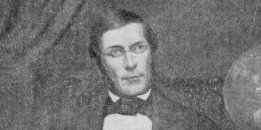M. A. Castrén 1841
The (Old) Kalevala became available to the Swedish speaking readers for the first time in 1841 when the translation by the linguist and ethnologist Mathias Alexander Castrén (1813–1852) was published. He had utilised both the translations by Runeberg and Ingman as well as the translation by Lönnrot in his work – the last one had, however, been “very much altered”, as noted by E. N. Setälä, an influential Finnish linguist and folklorist, in the Kalevalavihko in Valvoja in 1909.
The Kalevala’s journey out in the world truly began with the translation by Castrén. The Swedish text reached a multitude of readers compared to the original text, not only in its home country but also in the rest of Scandinavia. It was indeed through the translation by Castrén that the Kalevala got an enthusiastic and influential admirer in Jacob Grimm, who was one of the linguists, mythologists and story tellers known as the “Brothers Grimm”. An article by Grimm was published in 1845 and it contained excerpts of the poems in German that made the European readers aware of something that also the Finnish national poet J. L. Runeberg had been talking about: that the Kalevala should be regarded as one of the most important poetic epics in the world.

